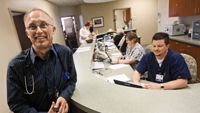Article
Patient-satisfaction improvements in small doses
Patient satisfaction builds practices' reputations.

Three years ago, Blessing was curious about how its patients viewed the practice and concerned that low satisfaction could hurt its reputation and revenue.
Management knew improving patient satisfaction would not be easy. Consultants had come and gone before without making long-lasting, substantial changes. Experience had taught physicians and staff to be skeptical of new initiatives.
But Blessing management knew that pay-for-performance was the future and patient satisfaction would play a large part in determining those scores.
"When patients come in we want them to have a positive experience every time. What we are trying to do is build deeper relationships with our patients," says Emily Robbearts, marketing and business development manager for the practice.
So Blessing hired two healthcare consulting firms: Studer Group, located in Gulf Breeze, Florida, and Press Ganey Associates of South Bend, Indiana, to see what it could do better.
SOLUTION: Press Ganey surveyed patients on their experiences at Blessing and showed the scores to physicians, who began protesting as soon as they saw them: The questions were biased; the samples were too small; doctors should be judged on standard of care and medical outcomes, not whether their patients liked them.
"Most doctors tend to be very Type A, and they don't like being measured," says Steven Krause, MD, an interventional cardiologist. "They want to be told they're great, that they're outperforming everyone."
Medical Director David Lockhart, MD, a family physician with a subspecialty in geriatrics, was confident that the initial patient satisfaction scores would show him near the top. But when the results came in, his patients had placed him in the lowest 10% nationwide.
"Turns out I wasn't as good as I thought I was," he says. "That was humbling. That was very humbling."
His family medicine colleague, Ginos, was stunned to find himself in the 18th percentile. "I sucked," he says. "I couldn't believe it. It was a real ego shot."
Once the surveys established that improvements were needed, Studer Group consultants and coaches, some of whom are physicians, visited to explain what the scores meant, why the doctors got them, and what they could do to improve, says Don Dean, a Studer Group senior account leader.
The changes they recommended were seemingly small but all part of placing the patient experience at the top of the priority list.
For example, patients scored Lockhart low on punctuality and taking the time to listen. A Studer Group consultant who'd shadowed him told him that he walked out of exam rooms without saying goodbye to the patients.
"I always thought it was enough to say, 'Well, do you have any more questions? No?' Boom, and I'm gone," Lockhart says. Now he takes the time to ask patients whether there is anything else on their mind and to really listen to them.
He was in the habit of visiting Blessing Hospital in the morning, which tended to make him late for practice appointments in the afternoon-something else his patients noted. Now, he takes care of his office visits, then goes to the hospital later in the day.
Similarly, Ginos no longer flips open his computer when he first walks into an exam room. And when he does start taking notes, he makes sure the patient knows that what he's typing is related to him or her. Sometimes he even will ask the patient to check his notes to make sure they're complete and accurate.





